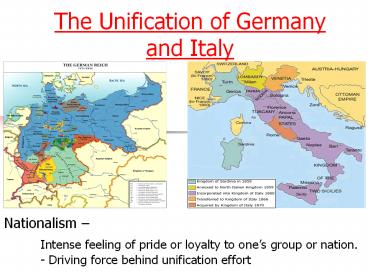The Unification of Germany and Italy - PowerPoint PPT Presentation
1 / 13
Title:
The Unification of Germany and Italy
Description:
The Unification of Germany and Italy Nationalism Intense feeling of pride or loyalty to one s group or nation. - Driving force behind unification effort – PowerPoint PPT presentation
Number of Views:200
Avg rating:3.0/5.0
Title: The Unification of Germany and Italy
1
The Unification of Germany and Italy
- Nationalism
- Intense feeling of pride or loyalty to ones
group or nation. - Driving force behind
unification effort
2
German Unification
- Early forms of unification
- Junkers
- Influential aristocratic landowners
- Persuaded Prussias leaders to do away with
Tariffs (breaks down trade barriers) - Zollverein
- Economic Union
- Reduced tariffs, other trade barriers
- Made uniform system of currency, and weights
3
PrussiaOtto Von Bismarck
- Appointed Prime Minister of Prussia by King
William I - Believed in strong government and powerful army
- Realpolitik (politics of reality)
- Blood and Iron speech
- War...if justified...could be used as a method of
expanding German interests
4
3 Wars
- War Against Denmark (1864)
- Dispute over Schleswig and Holstein
- Defeated by Prussia and Austria
- Schleswig to Prussia
- Holstein to Austria
- Seven Weeks War (1866)
- Prussia vs. Austria
- Prussia wins
- Ended chance of Austria being in control of
Germany - North German Confederation (1867)
- North of Main River
- Southern States
- Catholic
5
3 Wars (Continued)
- Franco-Prussian War
- Prince Leopold of Hohenzollern offered Spanish
throne - Cousin of William I of Prussia
- Napoleon III against this move
- No Hohenzollern on Spanish throne
- War begins July 19, 1870
- Southern states join northern states
- Prussians easily defeat French (4 months)
- Gain access to Alsace and Lorraine (France
bitter)
6
Formation of an Empire
- German states officially united (1871)
- technically separatebut united too
- (Kind of like our own 13 colonies)
- William I
- Kaiser
- Bismarck
- Chancellor
7
The Unification of Italy
8
Early Unification efforts
- Italian Nationalism
- Risorgimento (resurgence or revival)
- Desire for national independence
- Spurs effort to unite Italy
- Young Italy
- Giuseppe Mazzini (founder)
- Leads uprising Sicily (1848)
9
Piedmont (Sardinia)Count Camillo di Cavour
- Count Cavour
- Appointed Prime Minister by King Victor
- Emmanuel II
- Goals
- Industrial Growth
- Increase Piedmonts national interest in foreign
affairs by siding with foreign powers - Not a military power (have to be more diplomatic
than Prussia) - Ex. - Supported France and Britain in Crimean War
10
War with Austria
- France joins Piedmont against Austria
- Lombardy to Piedmont
- Austria keeps Venetia
- Cavours success leads to more rebellion in other
areas - Tuscany, Parma, Modena, Romagna demand to be
joined with Piedmont - April 1860
- Emmanuel II accepts the territories
- Savoy and Nice are given to France
11
Southern Italy
- Giuseppe Garibaldi
- Leader of nationalist group (Red Shirts) in
Southern Italy - Exiled after being part of a revolt
- Went to South America (Brazil) becomes an
expert in guerrilla warfare - 1860 takes control of Kingdom of Two Sicilies
- South is United with North 1861
- Garibaldi yields to Piedmont
- New state of Italy proclaimed 1861
12
Venetia and Rome
- Italy allies itself with Prussia (at war with
Austria) - Acquires Venetia
- Rome
- acquired due to Franco-Prussian War
- French troops pull out of Rome
- Emmanuel II moves capital from Florence to Rome
- Italy formally recognized as independent state in
1871
13
Similarities and Differences
- Ways the two unifications are similar
- Timing similar time frame (1815-1871) Why?
- Congress of Vienna v. Enlightenment
- Use military means to achieve goals (involved in
multiple wars) - Two major kingdoms/prime ministers lead way for
unification (Prussia/Bismarck and
Piedmont/Cavour) - Split between North and South
- Ways they are different
- Prussia has much stronger military force than
Piedmont Piedmont must rely more on alliances - Italian unification involves multiple leaders
(Mazzini, Cavour, Victor Emmanuel II, and
Garibaldi) and various nationalist groups to
rally people. Bismarck dominant figure in German
unification.

